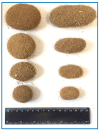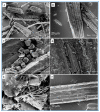Sustainable Exploitation of Posidonia oceanica Sea Balls (Egagropili): A Review
- PMID: 37108463
- PMCID: PMC10138933
- DOI: 10.3390/ijms24087301
Sustainable Exploitation of Posidonia oceanica Sea Balls (Egagropili): A Review
Abstract
Posidonia oceanica (L.) Delile is the main seagrass plant in the Mediterranean basin that forms huge underwater meadows. Its leaves, when decomposed, are transported to the coasts, where they create huge banquettes that protect the beaches from sea erosion. Its roots and rhizome fragments, instead, aggregate into fibrous sea balls, called egagropili, that are shaped and accumulated by the waves along the shoreline. Their presence on the beach is generally disliked by tourists, and, thus, local communities commonly treat them as waste to remove and discard. Posidonia oceanica egagropili might represent a vegetable lignocellulose biomass to be valorized as a renewable substrate to produce added value molecules in biotechnological processes, as bio-absorbents in environmental decontamination, to prepare new bioplastics and biocomposites, or as insulating and reinforcement materials for construction and building. In this review, the structural characteristics, and the biological role of Posidonia oceanica egagropili are described, as well as their applications in different fields as reported in scientific papers published in recent years.
Keywords: Posidonia oceanica; cellulose; egagropili; holocellulose; lignin; marine waste.
Conflict of interest statement
The authors declare no conflict of interest.
Figures






Similar articles
-
Valorisation of Posidonia oceanica Sea Balls (Egagropili) as a Potential Source of Reinforcement Agents in Protein-Based Biocomposites.Polymers (Basel). 2020 Nov 25;12(12):2788. doi: 10.3390/polym12122788. Polymers (Basel). 2020. PMID: 33255710 Free PMC article.
-
Enhanced Streptomyces roseochromogenes melanin production by using the marine renewable source Posidonia oceanica egagropili.Appl Microbiol Biotechnol. 2022 Nov;106(21):7265-7283. doi: 10.1007/s00253-022-12191-8. Epub 2022 Oct 6. Appl Microbiol Biotechnol. 2022. PMID: 36198867
-
Lignin/Carbohydrate Complex Isolated from Posidonia oceanica Sea Balls (Egagropili): Characterization and Antioxidant Reinforcement of Protein-Based Films.Int J Mol Sci. 2021 Aug 24;22(17):9147. doi: 10.3390/ijms22179147. Int J Mol Sci. 2021. PMID: 34502058 Free PMC article.
-
An Overview of New Insights into the Benefits of the Seagrass Posidonia oceanica for Human Health.Mar Drugs. 2021 Aug 25;19(9):476. doi: 10.3390/md19090476. Mar Drugs. 2021. PMID: 34564138 Free PMC article. Review.
-
Effects of disturbances caused by coastal constructions on spatial structure, growth dynamics and photosynthesis of the seagrass Posidonia oceanica.Mar Pollut Bull. 2003 Dec;46(12):1523-33. doi: 10.1016/j.marpolbul.2003.08.021. Mar Pollut Bull. 2003. PMID: 14643778 Review.
Cited by
-
Streptomycetes as Microbial Cell Factories for the Biotechnological Production of Melanin.Int J Mol Sci. 2024 Mar 5;25(5):3013. doi: 10.3390/ijms25053013. Int J Mol Sci. 2024. PMID: 38474259 Free PMC article. Review.
-
Integral Valorization of Posidonia oceanica Balls: An Abundant and Potential Biomass.Polymers (Basel). 2024 Jan 4;16(1):164. doi: 10.3390/polym16010164. Polymers (Basel). 2024. PMID: 38201829 Free PMC article.
-
Biotechnological Production and Characterization of Extracellular Melanin by Streptomyces nashvillensis.Microorganisms. 2024 Jan 30;12(2):297. doi: 10.3390/microorganisms12020297. Microorganisms. 2024. PMID: 38399701 Free PMC article.
References
-
- Mirpoor S.F., Giosafatto C.V.L., Di Pierro P., Di Girolamo R., Regalado-González C., Porta R. Valorisation of Posidonia oceanica sea balls (egagropili) as a potential source of reinforcement agents in protein-based biocomposites. Polymers. 2020;12:2788. doi: 10.3390/polym12122788. - DOI - PMC - PubMed
-
- Lefebvre L., Compère P., Léonard A., Plougonven E., Vandewalle N., Gobert S. Mediterranean aegagropiles from Posidonia oceanica (L.) Delile (1813): A first complete description from macroscopic to microscopic structure. Mar. Biol. 2021;168:37. doi: 10.1007/s00227-021-03833-y. - DOI
-
- Kumar A. Egagropili Sand Dunes (Holocene) along the southeastern Gulf of Sirte (Mediterranean Sea) coast of Brega, Libya. Geophytology. 2022;52:29–38.
Publication types
MeSH terms
LinkOut - more resources
Full Text Sources

